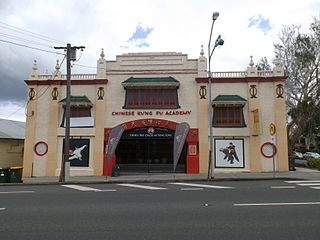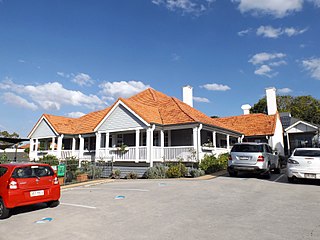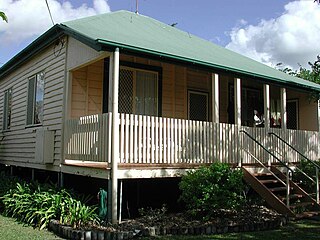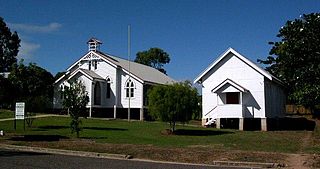
The Empire Theatre is a heritage-listed theatre at 56 & 56A Neil Street, Toowoomba, Toowoomba Region, Queensland, Australia. It was added to the Queensland Heritage Register on 31 May 1994.

The Brisbane Showgrounds is a multi-purpose venue located in Bowen Hills, Brisbane. Established in 1875, it hosts more than 250 events each year, the largest being the Royal Queensland Show (Ekka).

Wallumbilla is a rural town and locality in the Maranoa Region, Queensland, Australia. In the 2021 census, the locality of Wallumbilla had a population of 331 people. with 191 people living in the town itself.

Regent Theatre was a heritage-listed cinema at 167 Queen Street, Brisbane, Australia. It was designed by Richard Gailey, Charles N Hollinshed and Aaron Bolot and built from 1928 to 1929 by J & E L Rees and A J Dickenson. It was one of the original Hoyts' Picture Palaces from the 1920s. It is also known as Regent Building. The auditorium interior was largely lost when it was converted into a 4 screen complex in 1979–1980, but the building, including the surviving entrance and main foyer, was added to the Queensland Heritage Register on 21 October 1992.

Lady Bowen Hospital is a heritage-listed former maternity hospital and now social housing and office complex at 497–535 Wickham Terrace, Spring Hill, City of Brisbane, Queensland, Australia. It was designed by John H. Buckeridge and built from 1889 to 1890 by John Quinn. It was also known as Brisbane Lying-In Hospital and the Lady Bowen Hostel. It was added to the Queensland Heritage Register on 23 April 1999. The complex consists of the former hospital and nurses' quarters buildings; a third building which had been contained in the heritage listing was demolished c. 2005–2008.

University of Queensland Gatton Campus is a heritage-listed university campus of the University of Queensland at Warrego Highway, Lawes, Lockyer Valley Region, Queensland, Australia. It was built from 1897 to 1960s. It is also known as the Queensland Agricultural College, the Foundation Precinct Gatton College and Lawes Campus. It was added to the Queensland Heritage Register on 6 January 2004.

Plaza Theatre is a heritage-listed, former cinema at 163–169 Latrobe Terrace, Paddington, Queensland, Australia. It was designed by Richard Gailey, Junior and built from 1929 to c. 1929 by John Hutchinson. It is now known as Empire Revival, an antiques and homewares store. It was added to the Queensland Heritage Register on 28 March 2003.

Chelmer Police College is a heritage-listed former police barracks at 17 Laurel Avenue, Chelmer, City of Brisbane, Queensland, Australia. It was built from 1900 to 1970. It is also known as 10 WRAAC Barracks, The Lady Wilson Red Cross Convalescent Home, and Waterton. It was added to the Queensland Heritage Register on 1 October 2003.

Triumph Cinema, also known as Classic Cinema, East Brisbane Picture Theatre, and Elite Cinema, is a heritage-listed former cinema at 963 Stanley Street, East Brisbane, City of Brisbane, Queensland, Australia. It was designed by Arthur Robson and built in 1927. It is also known as East Brisbane Picture Theatre, Elite Cinema, and Classic Cinema. It was added to the Queensland Heritage Register on 27 July 2001.

Lyndhurst is a heritage-listed villa at 3 London Road, Clayfield, City of Brisbane, Queensland, Australia. It was designed by Robin Dods and built from 1896 onwards by Walls & Juster. It is also known as The Reid House. It was added to the Queensland Heritage Register on 12 December 2003.

Moreton Central Sugar Mill Worker's Housing is a heritage-listed group of houses at 17 & 19 Mill Street, and 14 & 16 Bury Street, Nambour, Sunshine Coast Region, Queensland, Australia. It was added to the Queensland Heritage Register on 16 May 2008.

Majestic Theatre is a heritage-listed theatre at 3 Factory Street, Pomona, Shire of Noosa, Queensland, Australia. It was added to the Queensland Heritage Register on 5 February 2009.

Paragon Theatre is a heritage-listed cinema and theatre at 75 Churchill Street, Childers, Bundaberg Region, Queensland, Australia. It was designed by Arthur Robson and built in 1927 by P Mellefont, Jnr. It was added to the Queensland Heritage Register on 28 April 2000.

Hotel Childers is a heritage-listed hotel at 59 Churchill Street, Childers, Bundaberg Region, Queensland, Australia. It was built from c. 1895 to 1930s. It is also known as Queen's Hotel. It was added to the Queensland Heritage Register on 21 October 1992.

Strathmore Homestead is a heritage-listed homestead at Strathmore Station on Strathmore Road, Springlands, Whitsunday Region, Queensland, Australia. It was built from the 1860s onward. It is also known as Strathmore Station. It was added to the Queensland Heritage Register on 13 November 2008.

St John's Anglican Church Precinct is a heritage-listed churchyard at 30–34 Macrossan Street, South Townsville, City of Townsville, Queensland, Australia. It was built from c. 1907 to c. 1911. It was added to the Queensland Heritage Register on 21 October 1992.

Majestic Picture Theatre is a heritage-listed theatre at 1 Eacham Place, Malanda, Tablelands Region, Queensland, Australia. It was designed by Bob Hassall and built in 1929 by Albie Halfpapp. It is also known as Majestic Theatre. It was added to the Queensland Heritage Register on 5 February 2010.

Murgon Civic Centre is a heritage-listed town hall at 62–70 Lamb Street, Murgon, South Burnett Region, Queensland, Australia. It is also known as Murgon Public Hall. It was designed by Clifford Ernest Plant and built in 1938 by HG Neilsen. It was added to the Queensland Heritage Register on 9 November 2012.

Hibernian Hall is a heritage-listed community hall at 38–44 Hawthorne Street, Roma, Maranoa Region, Queensland, Australia. It was designed by Cavanagh & Cavanagh and built from 1931 to 1932 by George Power Williams. It is also known as HACBS Hall. It was added to the Queensland Heritage Register on 27 April 2001.

Astor Theatre is a heritage-listed cinema at 77 Burrowes Street, Surat, Maranoa Region, Queensland, Australia. It was built from 1925 to 1960s. It was added to the Queensland Heritage Register on 27 September 2002.






















